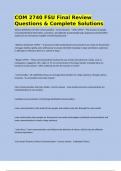COM 2740 FSU Final Review
Questions & Complete Solutions
Various Definitions of Mass Communication - Correct Answer *Orlik (1992)*: "The process of rapidly
conveying identical information, assertions, and attitudes to potentially large, dispersed and diversified
audiences via mechanisms capable of achieving that task."
*DeFleur and Dennis (1993)*: "A process in which professional communicators use media to disseminate
messages widely, rapidly, and continuously to arouse intended meanings in large and diverse audiences
in attempts to influence them in a variety of ways."
*Berger (1995)*: "[Mass Communication] involves the use of print and electronic media, such as
newspapers, magazines, film, radio, or TV, to communicate to the large number of people who are
located in various places - often scattered all over the country or world."
*commonality*: all 3 definitions focus on message dissemination to a large audience, through various
channels, *to accomplish some type of goal.*
Mass Communication and Mass Media - Correct Answer mass media and mass communication are
interdependent of one another
mediated communication is technology-facilitated communication
mass communication is the study of how people and entities relay info through the mass media
mass media exists when people (or businesses) use media technologies (mediated communication) and
mass communication to reach a large audience
*main focus*: how communication can influence the behavior of others, which is key for effective
business operations
4 (of many) Theories of Mass Communication - Correct Answer Cultivation Theory
,Uses and Gratifications Theory
Agenda Setting Theory
Two-Step Flow Theory
Cultivation Theory (Gerbner, 1998) - Correct Answer one of the most popular; widely used mass
communication research theories
argues that TV viewing can change people's perception of reality over time
operates with 3 main assumptions/considerations: the medium, the audience, and the functionality of
the medium on the audience
television is a unique medium and shapes the way people think and relate to one another - but the
effects are limited
been used to study gender roles, music videos, LGBTQ issues, and children's health
has primarily been studied with regard to violence on television
Uses and Gratifications Theory (Ruggiero, 2000) - Correct Answer examines why and how people seek
out specific media to satisfy specific needs
unique, audience-centered approach to understanding mass communication
implication that media compete with one another for attention. Mass communication professionals need
to understand how to best position themselves to reach their target audiences
led to research as to why we use our phones, internet, social media, etc.
Agenda Setting Theory (McCombs & Shaw, 1972) - Correct Answer *the media don't tell us what to
think; they tell us what to think about*
,1st assumption:
press/media do not reflect reality; they filter and shape it
2nd assumption:
media concentration on a few issues leads the public to perceive those issues as more important than
others
originally applied to politics, but can be expanded to business, advertising, and crime
Two-Step Flow Theory (Katz & Lazarsfeld, 1955) - Correct Answer Most people from their opinions from
opinion leaders, who form theirs from mass media. It incorporates two distinct steps.
opinion leaders often seen as more trustworthy/less biased than media
therefore, belief that these opinion leaders can have greater influence on larger groups of people
a theory that was once believed to be outdated, but now increasing in relevance due to things like blogs
and social media
Mass Communication Research Methods - Correct Answer *Surveys* (quantitative)
*Content Analyses* (quantitative)
*Focus Groups* (qualitative/more subjective)
*Observation* (qualitative)
Surveys - Correct Answer aims to generate data used to make generalizations about large groups of
people
, can be used for copy testing, evaluating products or campaigns, customer service, environmental
scanning, and gathering demographic data
can be done online, on phone, through the mail, or in person; can include closed and open-ended
questions
fast and cost-effective, but the integrity of responses can be a concern
- typically people respond the way they think they are supposed to respond which isn't honest
- focuses on correlation, not causation when interpreting results
Content Analyses - Correct Answer can also be called textual analysis/es
identifying categories from a specific type of communication to see what the content of that
communication typically includes
*5 sources of text:* written; oral; iconic (drawings/paintings, etc.); AV (TV programs, movies, etc.); and,
hypertexts (online texts)
trying to understand "who says what, to whom, why, to what extent - and with what effect?" can help
identify a media slant or bias
Focus Groups - Correct Answer bringing people together to discuss their thoughts/opinions on
something
the interactive nature of a focus group is what sets it apart from the other research methods
used heavily in marketing
not expensive, but takes a lot of time
researcher needs to take careful notes for playback and evaluation




